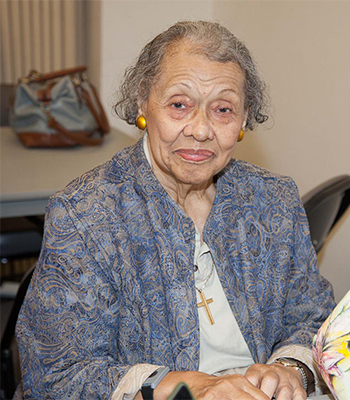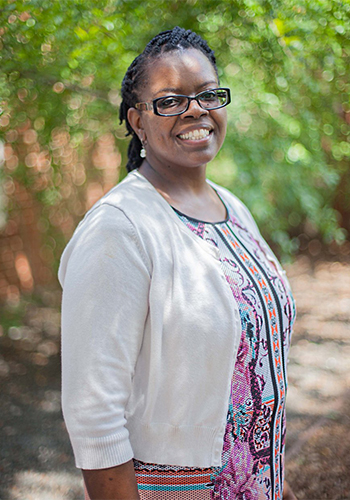Reuniting the Black Family: Volunteers Index Freedmen’s Bureau Records
Contributed By Linda Talbot, Church News Contributor
.jpg)
Researcher Camilla Jackson, with over 10,000 names in her family tree, learns indexing.
Article Highlights
- FamilySearch volunteer indexers are working to index historical African-American records and teach others how to do the same.
- The goal is to complete this indexing project in time for the opening of the Smithsonian’s National Museum of African American History and Culture in the fall of 2016.
“Once you get into the slave age, even when you find the records of the slave owners, you are often lost or stopped. This will really help. With this indexing, I won’t have to go all over; I can do it from home. Genealogy ought to be available to all.” —Camilla Jackson, African-American Historical and Genealogical Society member
Related Links
At its September meeting, members of the Houston Texas Chapter of the African-American Historical and Genealogical Society (AAHGS) heeded the “call to action” issued by FamilySearch as they received instruction on indexing Freedmen’s Bureau Records from volunteers of the Friendswood Texas Stake.
Jesse Williams, chapter president, who had successfully learned the indexing process, enthusiastically supported the Freedmen’s Bureau Records Project, as it mirrors the AAHGS goal stated on their website. “Our primary task is to nurture the interest and collaboration of genealogical and family history research. … We believe that the collective compilation and corroboration of our family histories will generate a more accurate portrayal of African American family life, history, and culture. … We believe that through these endeavors the restoration and strengthening of the African American family is made possible.”
As emancipation freed nearly 4 million slaves, the Freedmen’s Bureau (1865–1872) was established by Congress to help transition them from slavery to citizenship, providing food, housing, education, and medical care. For the first time in U.S. history, the names of those individuals were systematically recorded and preserved, including marriages, labor contracts, land and property, medical care, military service and school documents, and family relations and brief oral histories.
FamilySearch International, the largest genealogical society in the world, purchased copies of these records and scanned them for the purpose of indexing. Indexing involves volunteers reading the original records and capturing pertinent information that is typed into searchable fields. FamilySearch has partnered with AAHGS, the National Archives and Records Administration, California African American Museum, and the Smithsonian Institution. The goal is to complete this indexing project in time for the opening of the Smithsonian’s National Museum of African American History and Culture in the fall of 2016 so that they may be freely accessible online to all and to walk-in museum visitors.
Helen Jackson-Graham, English professor and LDS indexer for over 20 years, introduced the training. “Research has shown children who know where they came from are more resilient. They are able to handle problems, do better in school and better socially because they know they are part of something larger than themselves,” she said.
The theme of “Reuniting the Black Family” was reiterated by George Allen, AAHGS past president and current director of Red River Sankofa Historical Society, specializing in the restoration and preservation of African American graveyards. As he and Jackson-Graham conversed, they discovered they had a common ancestral name. Both pulled up their family trees on their tablets, compared notes, and found the link. “It’s not a matter of whether we’re related or not, it’s how far do we want to go back to make the connection,” Mr. Allen said.

Octogenarian and founding member of AAHGS, Bettye Nelson White, came to be trained in indexing records. Photo by Jennifer Martino.

Sister Helen Graham from the Houston Texas South Stake is the Houston area Freedmen’s Bureau coordinator and has 20 years of experience in African American genealogical research. Photo by Jennifer Martino.
Mr. Allen is in full agreement with AAHGS’s backing of the Freedmen’s indexing project. “Even though they are doing other people’s families, it gets them into the idea of how to do research, how to read records, so when they find their family records, they are able to read them. Linking to other families sometimes brings you right back around to your own family.”
Franklin Smith, senior library services specialist with the Clayton Library Center for Genealogical Research in Houston, where the training was held, is author of Genealogists Guide to Discovering Your African American Ancestors. “This is absolutely wonderful,” Smith said. These records add another bridge between the post–Civil War era and the pre–Civil War era. They give real insight into what the former slave’s life was like during that period of transition. Smith has done some indexing himself. “It is a lot easier than I thought,” he said.
Octogenarian Bettye Nelson White, a founding member of the local AAHGS chapter whose illustrious career is chronicled on the AAHGS website, author and former director of the Child Development Laboratory at Texas Southern University, has been interested in family history since she was young. “This work is so important,” she said. “It used to be ‘mouths closed’ about family. It is so rewarding to know about your ancestors and find out about where you came from. I recommend it to everyone.”
Tony Coverson traveled from San Antonio to attend the workshop at the insistence of his cousin, an AAHGS member. “I have been doing research since 2007,” he said. “We have had a lot of roadblocks finding family, and I am hopeful that this will be a doorway for me to walk through.”
AAHGS member Camilla Jackson, a researcher of over 30 years with a family tree including over 10,000 people, compared Freedmen’s Records indexing to a gift of love. “Once you get into the slave age, even when you find the records of the slave owners, you are often lost or stopped. This will really help. With this indexing, I won’t have to go all over; I can do it from home. Genealogy ought to be available to all,” she said.
Jackson encouraged everyone to do the indexing. “I was trying to make it more complicated than it was,” she said. “You just follow the instructions. The [LDS] volunteers made me feel a lot better.”
Each set of records is organized into small batches, so time is not a constraint. There are step-by-step instructions and help sections for each record.
Kizzy Branch, visiting for the training, echoed, “It’s really quite simple once you learn what to do. My goal is to have my two daughters get involved and participate.”
LDS volunteer trainers reported that young people from eight years old and up have been successful at indexing, making this another way to reunite black families.
So far 19 percent of the over 4 million Freedmen’s Bureau Records have been indexed. More volunteers are needed to help reach the goal. The project’s website is http://www.discoverfreedmen.org.
For inspiring stories and videos, use #DiscoverFreedmen.

AAHGS indexing conference attendees register. Photo by Jennifer Martino.

AAHGS genealogical indexing training at Clayton Library Center for Genealogical Research in Houston. Photo by Jennifer Martino.

George Allen, past president of AAHGS, with Sister Helen Graham and Joann and Jesse Williams, current AAHGS leader. Photo by Jennifer Martino.

Trainer and student confer at AAHGS indexing conference. Photo by Jennifer Martino.

Sister Amy Hogan provides one-on-one training assistance in records indexing. Photo by Jennifer Martino.

Hands-on indexing training breaks down fears about using computers in research. Photo by Jennifer Martino.

Chapter president Jessie Williams (left) confers with Brother Sam Arungwa. Photo by Jennifer Martino.

Copies of historic documents are part of the genealogical training. Photo by Jennifer Martino.

Friendswood Texas Stake volunteers provide indexing training to conference attendees. Photo by Jennifer Martino.
